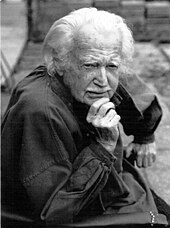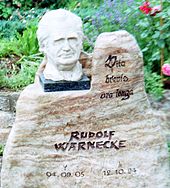Rudolf Warnecke
Rudolf Warnecke (born September 4, 1905 in Bautzen , † October 12, 1994 in Ravenstein -Merchingen) was a German graphic artist and wood cutter.
Life
As the son of an architect, Warnecke attended the Weigang brothers' art institute in Bautzen in 1918. In 1923, together with the painter Karl W. Schmidt, he founded a studio for advertising graphics in Zittau, and one year later he joined the East Saxony service as a press draftsman.
In 1926 he studied at the Academy for Graphic Arts in Leipzig in the etching class with Alois Kolb and from 1928 worked as an illustrator for various publishers. 1931 followed the first publication as a wood cutter "The wood cut" in the Körner-Verlag, Stuttgart.
With his 1933 work Alt-Bautzen , Praise of Work ; Mother's love and the dance of death Warnecke turned to free woodcut. A year later the first publication took place in the monthly Kunst und Leben from Fritz Heyder-Verlag, Berlin-Zehlendorf.
In 1936 exhibitions followed with purchases of the graphic cabinets in Bautzen, Dresden, Leipzig, the Görlitz Hall of Fame and the Stockholm National Museum. The National Socialists took over his artistic work in 1940 with a graphic exhibition in Leipzig with Arthur Kampf and Karl Truppe . Due to the refusal to join the NSDAP and the Reich Chamber of Culture, the position of exhibition manager at the Bautzen City Museum was resigned and he was called up for military service.
After being prisoner of war in the Heilbronn camp in 1945 , he moved to Dinkelsbühl . Portraits of prominent personalities followed in 1946: Apostolic Nuncio Aloysius Muench , Marshal of the int. Mil. Trib. Nuremberg Robert H. Jackson , Matthias Wiemann , Marianne Hoppe , Hermann Claudius , Ludwig Tügel , Victor von Gostomski a . a.
In 1947, American and Soviet printing licenses for the Dohlen-Verlag in Dinkelsbühl and Römer-Verlag in Dresden enabled the first publications after the war. 1949–1951 he created several sgraffito, mainly on public buildings in Germany and other European countries such as B. Wall paintings in the House of Youth in Tempelhof and sgraffitos in Barksen, Westerland and Hörnum (Sylt). Trips to Sylt marked the beginning of year-round exhibitions from 1952 in Westerland and Kampen.
In 1959 Warnecke acquired an estate in Dinkelsbühl as a studio house with exhibition rooms. A year later a second studio was set up in a tower in Crailsheim. From 1961 Warnecke held year-round portrait exhibitions in Bad Mergentheim and became a graphic designer for the Deutschherren publishing house located there. Three years later, portrait exhibitions took place in Bad Pyrmont.
In 1966 Rudolf Warnecke married his wife Friedlinde, from this marriage the daughter Tatjana Warnecke emerged. He settled in Ravenstein-Merchingen in 1969. 1975-77 followed several exhibitions in Munich and Crailsheim and a special exhibition in Rothenburg ob der Tauber. In 1980 the workbook “With goose foot and burin through an artist's life - 100 woodcuts from 6 decades” was published by the Ravenstein Gallery. 1981–1982 Warnecke undertook study trips to Greece, Italy and California, followed by the joint exhibition in Paso Robles (USA), Berlin and Munich together with Frans Masereel , A. Paul Weber and Josef Hegenbarth . The following year he created the 36 m mural “Peasants' War” in the idol palace Ravenstein. In 1985 anniversary exhibitions took place in Munich, Bautzen, Dinkelsbühl, Mölln and Kronach. In the same year he became an honorary citizen of the city of Ravenstein. In 1989 he created the portrait of the space pioneer Hermann Oberth .
A few years before his death, Warnecke returned to his native Bautzen and created 20 large-format oil paintings with "Alt-Bautzen", the "Budissin'sches Mosaik" with 50 illustrations on the history of Bautzen, its legends and originals (Lusatia-Verlag, Bautzen), as well as a new edition of 20 woodcuts from the medieval city of Bautzen (published by Galerie Ravenstein) on the occasion of the celebrations of the millennial city.
Rudolf Warnecke died in Merchingen in 1994 at the age of 89.
Awards and honors
- Prize winner in the illustration competition of the Main-Presse-Verlag in Würzburg "Das Deutsche Volkslied" (1950)
- Winner in the poster competition of the city of Dinkelsbühl. (1951)
- Pygmalion Medal of the German Economy in Munich. (1988)
- Golden badge of honor of the German Sports Confederation. (1990)
- Awarded the international gold medal "Recherche de la Qualite" from the OSF in Paris. (1983)
- Golden Ring of Honor for Fine Arts, Munich. (1975)
literature
- The wood cutter Rudolf Warnecke. Dohlen-Verlag, 1956, DNB 455376689 .
- Emil Eichhorn: Laderhosn and fur vest. Rhyming and inconsistent in Upper Lusatian dialect. (= Voices of the Landscape. Volume 19). Bastei-Verlag Dresden, DNB 579715205 . (With 4 drawings by Rudolf Warnecke)
- Rudolf Warnecke: With goose foot and burin through an artist's life. 100 woodcuts from 6 decades. Galerie Ravenstein, 1980, OCLC 631809593 .
- Erich Klausnitzer , Rudolf Warnecke: Budissinian legends . (= Lausitzer Land. 1). 3rd revised and greatly expanded edition. Lausitzer Druckhaus, Bautzen 1991, OCLC 312835135 .
Web links
- Portrait of the artist Rudolf Warnecke 1905–1994
- Overview of works by Rudolf Warnecke
- City news City of Crailsheim on the 100th birthday, memory of Warnecke
| personal data | |
|---|---|
| SURNAME | Warnecke, Rudolf |
| BRIEF DESCRIPTION | German graphic artist and wood cutter |
| DATE OF BIRTH | 4th September 1905 |
| PLACE OF BIRTH | Bautzen |
| DATE OF DEATH | October 12, 1994 |
| Place of death | Ravenstein -Merchingen |


